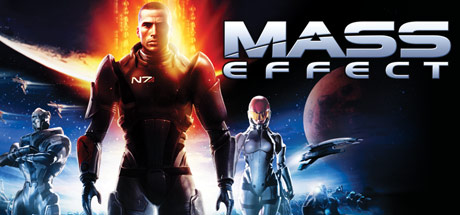
Yep, it’s time again for another entry in the rapidly growing “BioWare games I’m critical of category”, but for good reason. BioWare provides great case studies for games that had huge ambitions but perhaps not enough resources or time. No matter what gripes I have about their games, I can’t deny that they were trying to do awesome work with the medium. And nowhere is that more apparent than the first Mass Effect game, which tries admirably to give us a game in which both the gunplay and RPG elements were strong, but doesn’t really succeed in either way.
As usual, I want to preface the nitty-gritty with a bit of context about why this game may have made some of its design decisions. And really, all you need to know is that almost exactly a year prior to Mass Effect’s release, we saw the release of Gears of War, the game that exploded the “chest-high wall cover shooter” genre. I’m sure this game was in production before Gears of War came out, but I have a sneaking suspicion that the combat was heavily modeled after it. Why? Well, primarily because Mass Effect doesn’t seem to understand how the level design should complement this choice of mechanics.
To illustrate what I mean, let’s take one mission in particular and break it down. One of the quests you can take sends you to Earth’s moon to deactivate a rogue virtual intelligence that has taken control of the automated defenses. Seems easy enough, just roll up to the base in your glorified shopping cart and fight through a few drones. However, like all of these planetside bases, the map is built from a template that uses exclusively tiny rooms and tight corridors. This wouldn’t be a problem, except there are upwards of 20 enemies and only cover that leaves a flank exposed. This means that no matter where you choose to make your stand against the drones, you’re gunned down in seconds. This seems to suggest that the level designers didn’t understand how to make the layout of an area match the purpose they intended to use it for, making it a problem where none of the developer’s intended solutions work.
Spatial problems are much more important in shooters than in RPGs, and I think this is where BioWare’s history as a developer hurts them a little. But speaking of RPGs, this game doesn’t really function well as one of those, either. One of the core mechanics of RPGs is a class system that lets the player choose their own playstyle. But for that choice to be meaningful, the styles have to be substantively different. In Mass Effect, there really is no reason to choose anything other than specializing in weapons use. You can spec in the “biotic powers” like Push and Lift, but these are single-target attacks that do minimal damage and don’t incapacitate an enemy for nearly long enough to be useful. After taking wind-up animations into account, it’s likely that you could have just killed whatever you used your powers on in the time it took to use the power. This makes gun usage a First Order Optimal Strategy, because nothing else the game presents you could possibly be as effective.
So, as a shooter that doesn’t understand level design and an RPG that doesn’t understand how to design classes, why did people love this game so much? Easy, BioWare is quite honestly the king of narrative and companion writing. Even as someone who wasn’t particularly fond of this game, I was kind of bummed out that Tali wasn’t a romance option. The characters are compelling enough that you actually get invested, and they serve as bridges into understanding the larger story going on. Instead of feeling like side content, it boosts the strength of the overall piece. Still, all the great writing in the world won’t make Mass Effect a great game, even if it does offer lessons that the rest of the industry could stand to learn.
And what lesson do we take away as designers? Well, primarily that if you’re going to mix two genres of video game, you have to make sure that you understand what works about at least one of them. A comparison I often make when talking about this game with friends is Fallout 3 and New Vegas. I love those games even though the gunplay is pretty awful. Why? Because the shooting isn’t really the game’s primary engagement vector; the skill system is. If the game were really about the shooting, why would you be given so many ways to avoid combat altogether? In those games, the guns are implemented more as a small switch-up to an established format of games, and they’re better for it. Mass Effect tried something ambitious with mixing the two, but a lack of real understanding of what works about those genres and what elements of each would mesh together well prevents this game from fulfilling its potential.
This review could be much longer, talking about the more obvious design flaws like the Mako or the amazingly terrible inventory management system, but those have been discussed at length already and why they don’t work is fairly obvious. But the issue of slapping RPG elements in places they don’t necessarily belong is ongoing. It seems like every game now needs a leveling system or needs a crafting system, even if it doesn’t match any of the other modes of engagement. Even Fallout 4, a game I rather enjoy, has this issue in spades. Messing with settlement creation feels like swapping over into a totally different game, and while both the main game and the settlement portion are fun I don’t think this break in flow and immersion serves the game overall. We can still learn from the mistakes of older games, and I want that message to be loud and clear.